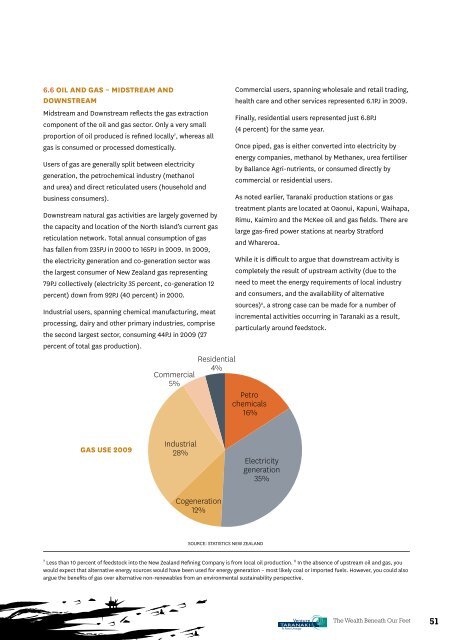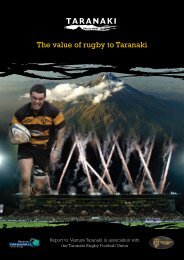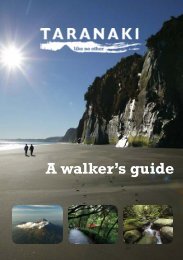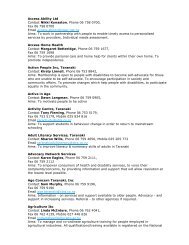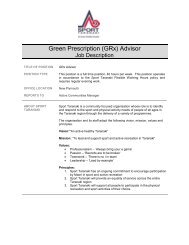The Wealth Beneath Our Feet - full report (6.4 MB ... - Venture Taranaki
The Wealth Beneath Our Feet - full report (6.4 MB ... - Venture Taranaki
The Wealth Beneath Our Feet - full report (6.4 MB ... - Venture Taranaki
Create successful ePaper yourself
Turn your PDF publications into a flip-book with our unique Google optimized e-Paper software.
6.6 OIL AND GAS – MIDSTREAM ANDDOWNSTREAMMidstream and Downstream reflects the gas extractioncomponent of the oil and gas sector. Only a very smallproportion of oil produced is refined locally 7 , whereas allgas is consumed or processed domestically.Users of gas are generally split between electricitygeneration, the petrochemical industry (methanoland urea) and direct reticulated users (household andbusiness consumers).Downstream natural gas activities are largely governed bythe capacity and location of the North Island’s current gasreticulation network. Total annual consumption of gashas fallen from 235PJ in 2000 to 165PJ in 2009. In 2009,the electricity generation and co-generation sector wasthe largest consumer of New Zealand gas representing79PJ collectively (electricity 35 percent, co-generation 12percent) down from 92PJ (40 percent) in 2000.Industrial users, spanning chemical manufacturing, meatprocessing, dairy and other primary industries, comprisethe second largest sector, consuming 44PJ in 2009 (27percent of total gas production).Commercial5%Residential4%Commercial users, spanning wholesale and retail trading,health care and other services represented 6.1PJ in 2009.Finally, residential users represented just 6.8PJ(4 percent) for the same year.Once piped, gas is either converted into electricity byenergy companies, methanol by Methanex, urea fertiliserby Ballance Agri-nutrients, or consumed directly bycommercial or residential users.As noted earlier, <strong>Taranaki</strong> production stations or gastreatment plants are located at Oaonui, Kapuni, Waihapa,Rimu, Kaimiro and the McKee oil and gas fields. <strong>The</strong>re arelarge gas-fired power stations at nearby Stratfordand Whareroa.While it is difficult to argue that downstream activity iscompletely the result of upstream activity (due to theneed to meet the energy requirements of local industryand consumers, and the availability of alternativesources) 8 , a strong case can be made for a number ofincremental activities occurring in <strong>Taranaki</strong> as a result,particularly around feedstock.Petrochemicals16%GAS USE 2009Industrial28%Electricitygeneration35%Cogeneration12%SOURCE: STATISTICS NEW ZEALAND7Less than 10 percent of feedstock into the New Zealand Refining Company is from local oil production. 8 In the absence of upstream oil and gas, youwould expect that alternative energy sources would have been used for energy generation – most likely coal or imported fuels. However, you could alsoargue the benefits of gas over alternative non-renewables from an environmental sustainability perspective.<strong>The</strong> <strong>Wealth</strong> <strong>Beneath</strong> <strong>Our</strong> <strong>Feet</strong>51


